Hoffenheim went to this match with a bad mood. The reason is simple: they hadn’t won a single match in their last seven games, and only drew three of them. If we step back a little further, their last win came against Bayer Leverkusen in early February; almost four months ago.
A similar mood could be found within 1. FC Köln’s squad. Since Bundesliga announced its return after the unwanted break, they only managed to get two points from two matches. Both teams were in a need of a win to get closer to the European zone. At the end of the day, the home side came out victorious and get closer to the desired land. Without further ado, this tactical analysis will inform you how the match unfolded.
Lineups
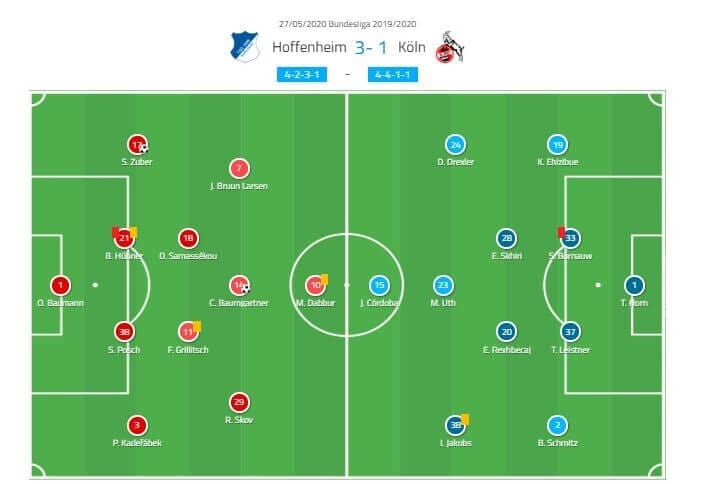
Alfred Schreuder picked 4–2–3–1 for his team. The duo of Pavel Kadeřábek and Steven Zuber was picked to be the full-back pairing. In front of them, the former Borussia Dortmund player Jacob Bruun Larsen was chosen to play alongside Christoph Baumgartner and Robert Skov as the attacking midfielders. In front of them, Munas Dabbur spearheaded the offensive line. Hoffenheim’s bench was filled with names like Håvard Nordtveit, Sebastian Rudy, Dennis Geiger, and Ihlas Bebou.
Similarly, Markus Gisdol opted for the same formation. At the heart of the defence, Toni Leistner started the game alongside Sebastiaan Bornauw. Ellyes Skhiri and Elvis Rexhbecaj were given the license to control the engine room in front of the centre-backs. Talisman Jhon Córdoba was trusted to lead Köln’s attacks. 2016 Confederations Cup winner Jonas Hector had to start the match from the dugout, as well as Jorge Meré, Florian Kainz, Anthony Modeste, and Simon Terodde.
Köln’s collective defending
The away side used a medium-high 4–2–3–1 press to contain Hoffenheim. It means that they would let the opponents’ centre-backs to have the ball within their first third. Köln’s main objective in their defensive tactics was to close the central presence and force Hoffenheim to play wide.
The away side were also deploying a rather high defensive line. The reason was to minimize the space in between the lines and prevent Hoffenheim from penetrating through the central area. This approach had another advantage. It could also force Die Kraichgauer’s deep players to play the ball long as there was limited space to play it short.
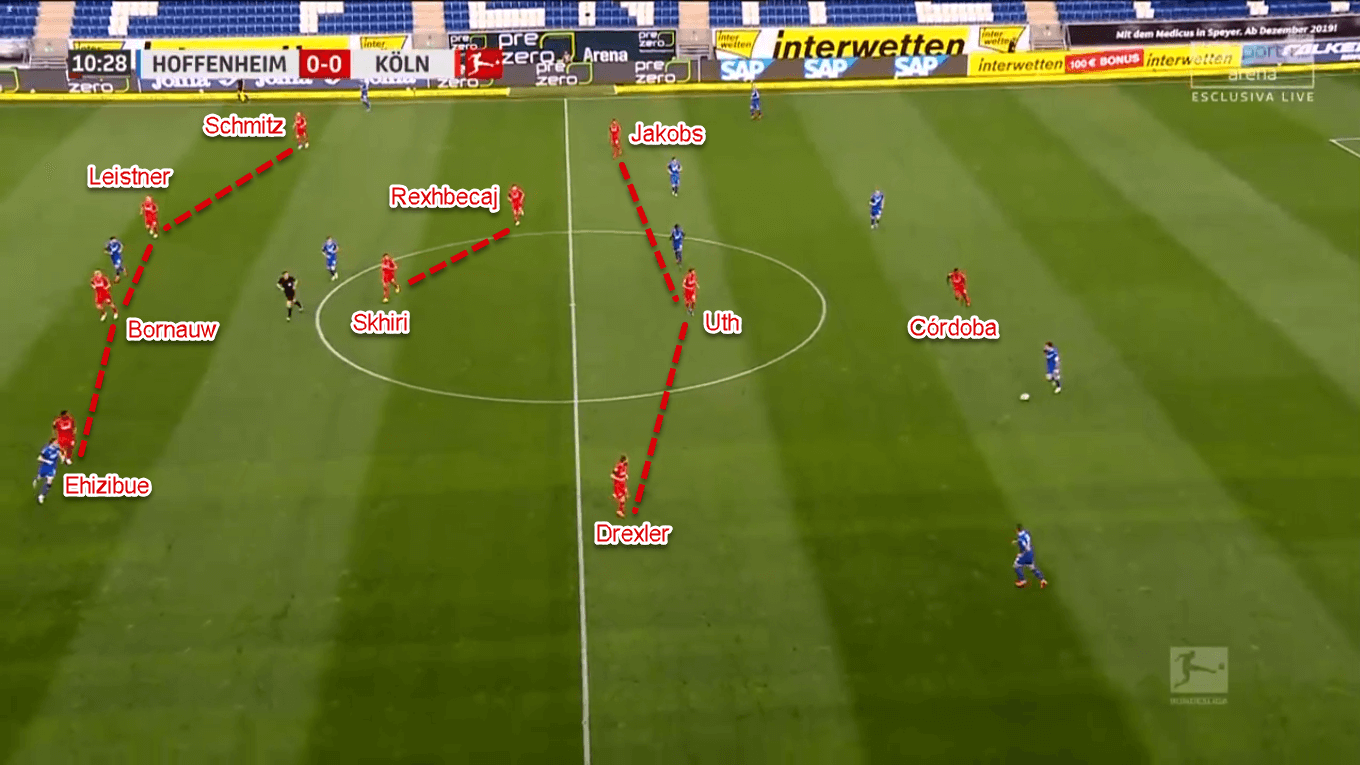
When the ball went wide, Gisdol instructed his players to overload the flank. It means that the two nearest defenders, the defensive midfield pairing, the ball-side winger, as well as the attacking midfielder would come close to flood the wide area. Sometimes, the centre-forward would also come close to prevent a backward pass.
Yet, the far-side winger didn’t join the press. He would stay in his position to prevent Hoffenheim to make a diagonal pass easily. The calculated defending worked quite well and forced the home side to restart their play several times.
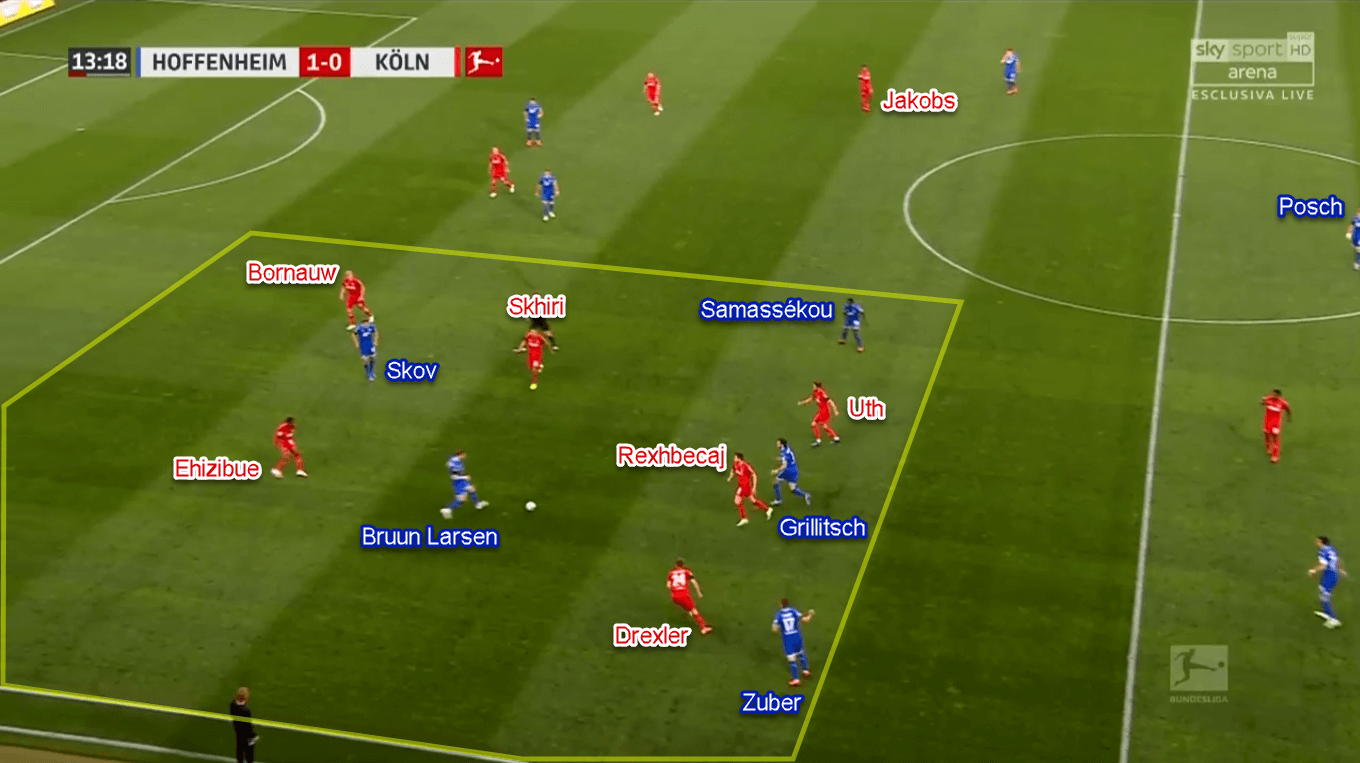
As collective their defence might be, playing a high defensive line was a risky choice. Any lapse of concentration could end up in big trouble. That was the case when Bruun Larsen got away from Kingsley Ehizibue’s marking to set up Baumgartner’s first goal. But, Hoffenheim were more than just lucky …
Heavy rotation from Hoffenheim
In this part of the analysis, we’re going to examine Hoffenheim’s offensive ideas. Hoffenheim were limited to play long passes — either vertical or diagonal —due to Köln’s systematic defending. They reacted to this quite well by allowing their players to rotate. First, the midfielders. In the lineup sheet, we could see that Hoffenheim used a 4–2–3–1 shape. However, it looked that they used a midfield trio with different roles for each player.
Florian Grillitsch was given the license to drop alongside the centre-backs, either centrally or inside the right half-space. By doing so, he helped the home side to make a numerical superiority at the back. In front of him, Diadie Samassékou had a different role. The Malian midfielder was tasked to stay central and bridge Hoffenheim’s lines in their attacks.
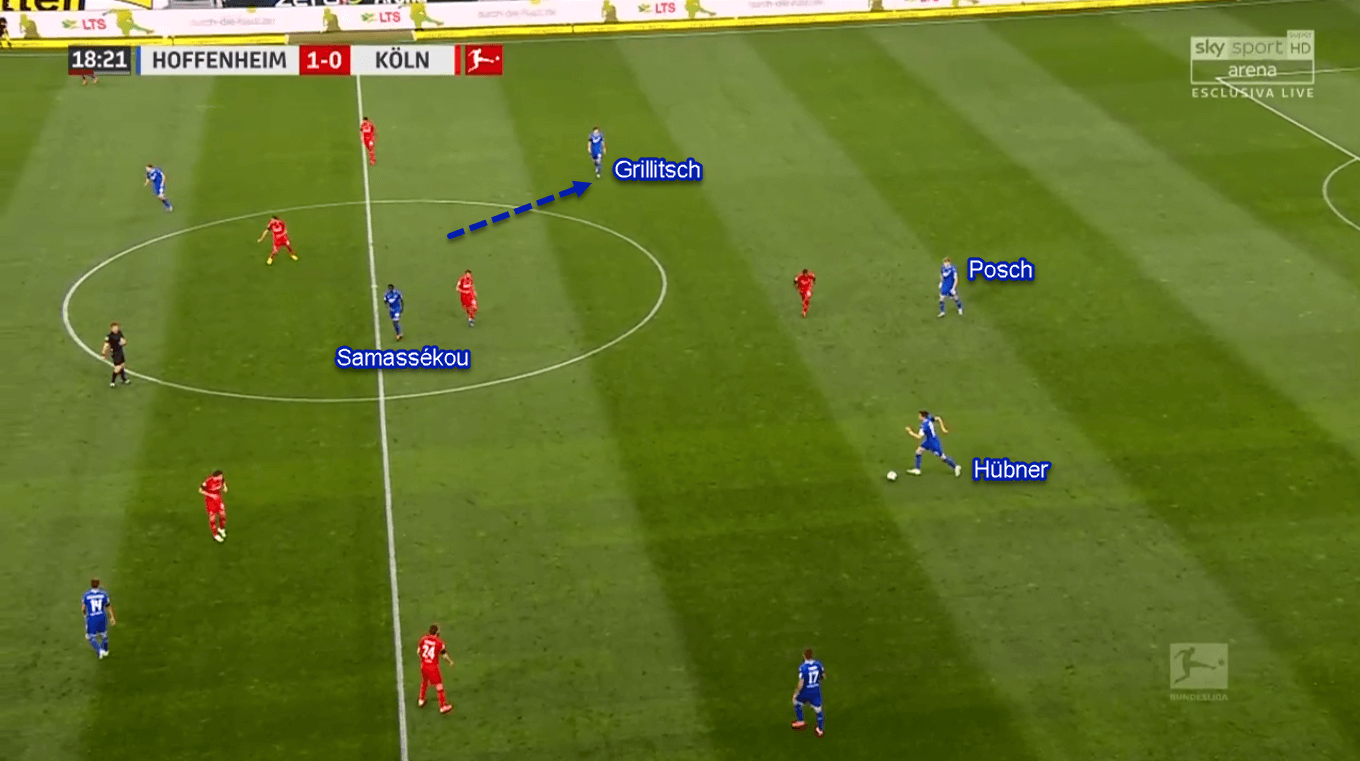
The most interesting role was given to Baumgartner. The 20-year-old was allowed to move rather freely in the final third. By doing so, he could appear in the pockets of space or join the attacking line alongside Dabbur at times. Such freedom helped him to bag two goals; or a hattrick if he wasn’t caught offside in the first half.
The rotation also happened in the flanks. In the right-hand side, Skov was tucked inside alongside Dabbur. This would allow Kadeřábek to bomb forward and provide the width. Oppositely, Zuber was the full-back instructed to play inside, while Bruun Larsen plays in the flank. Such rotations made Hoffenheim could be seen in a lopsided 3–2–5-ish shape on the ball.
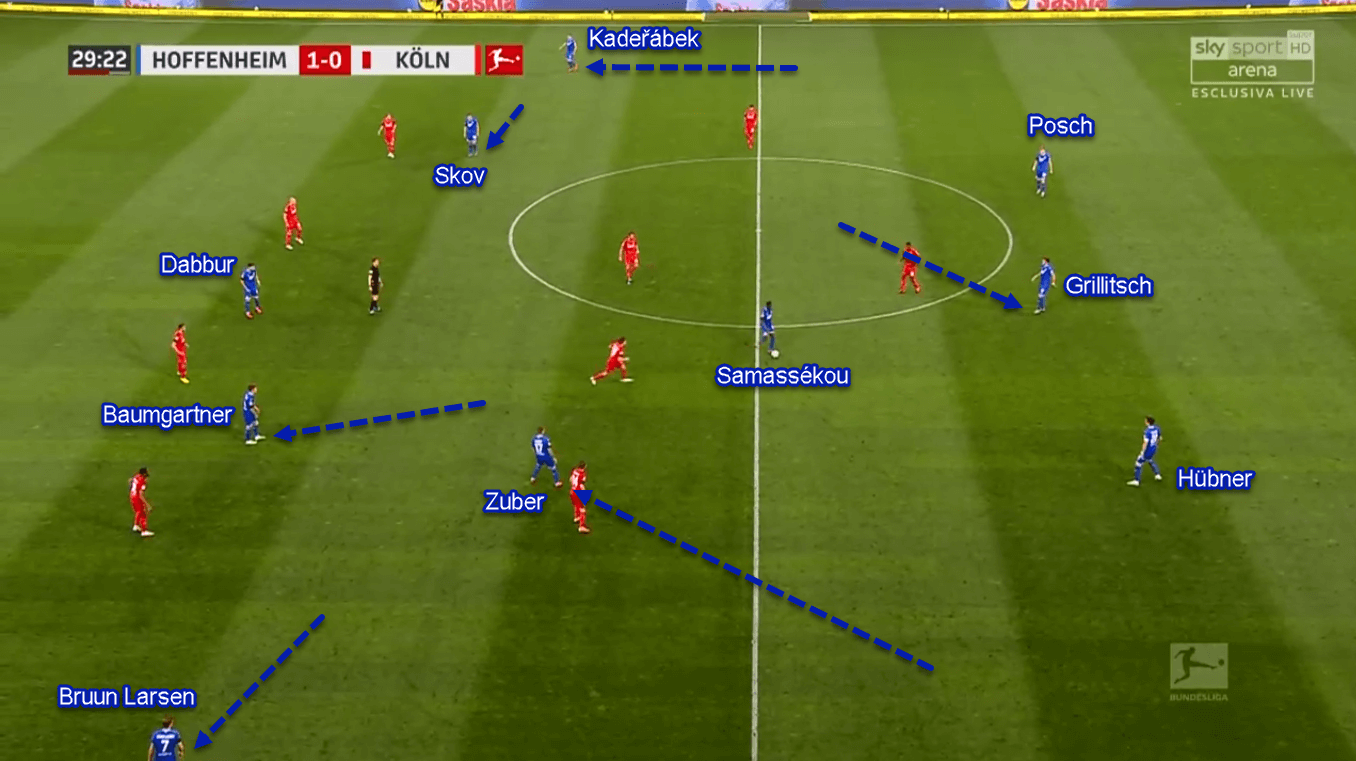
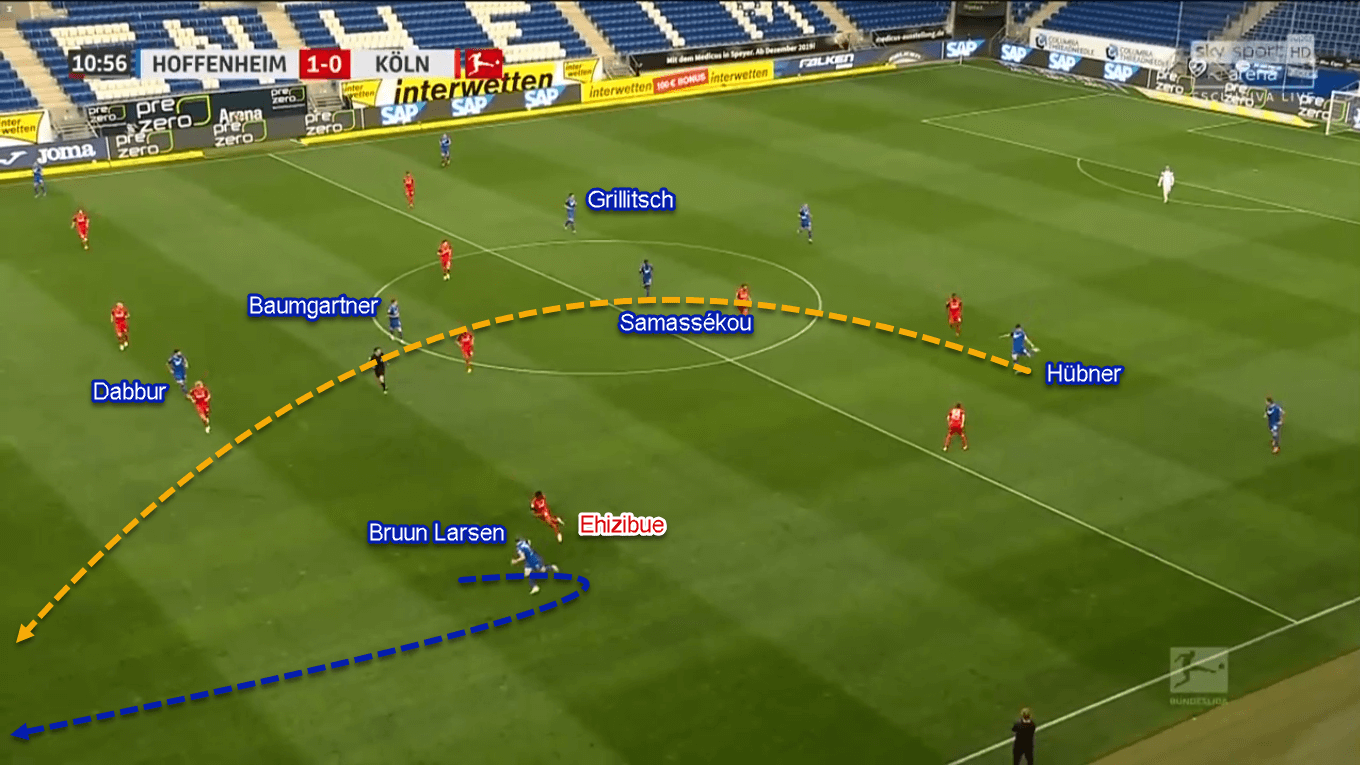
Köln tried to chase the game
Die Geißböcke reacted to the quick goal by being more active on the ball. Similarly, they also used rotation to try progressing the ball into the final third. Firstly, Gisdol instructed one of his midfielders to drop alongside the centre-backs. However, the task was more given to Rexhbecaj as Köln attacked from the left side more often in the first half.
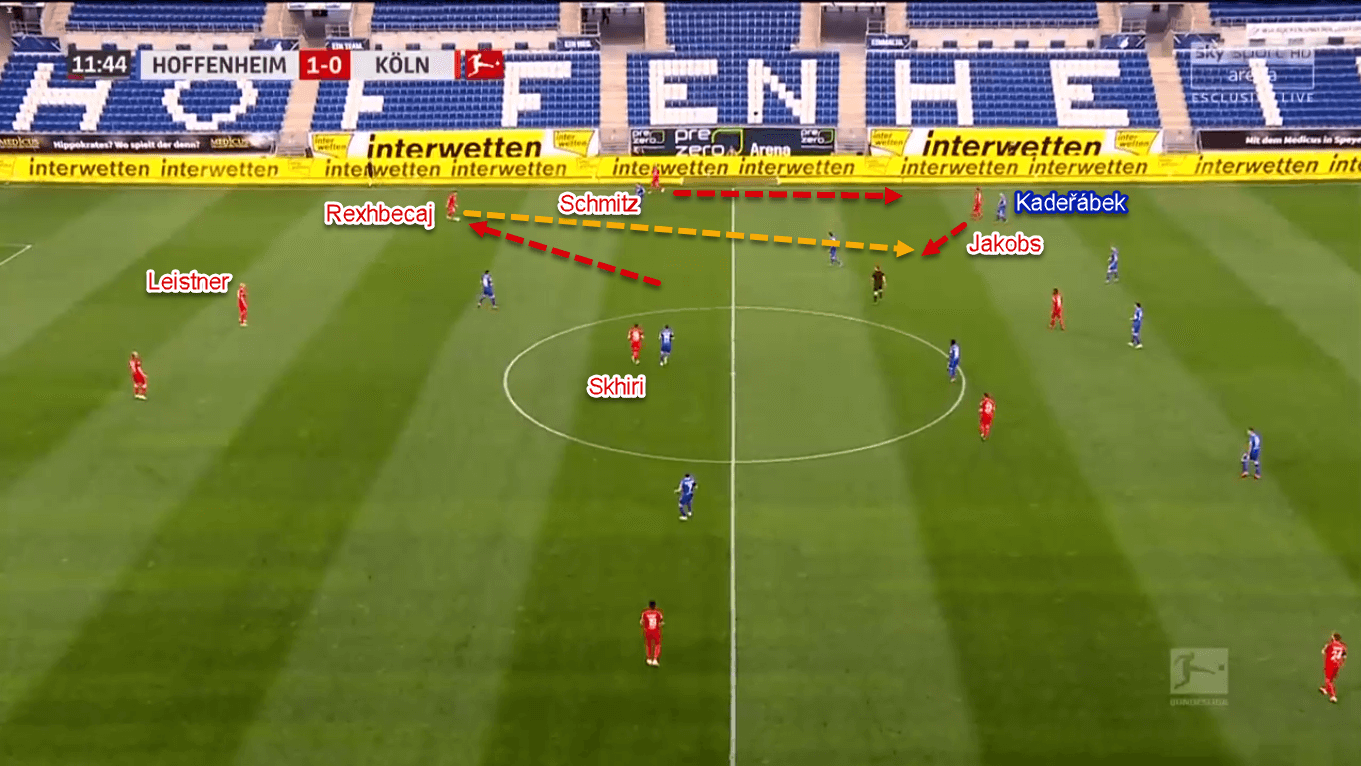
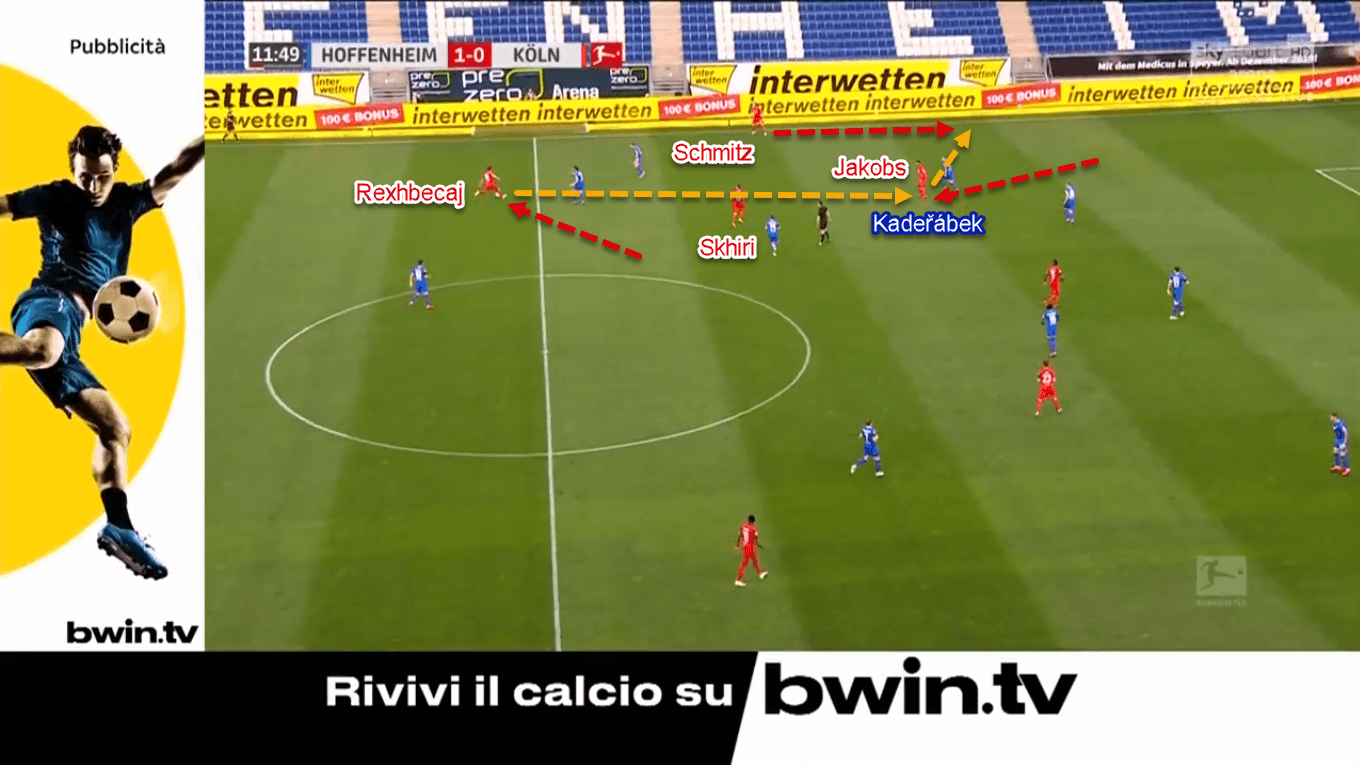
When Rexhbecaj drops, it would open space in his vacated area. This space then primarily would be filled by tucking-inside Jakobs. Nevertheless, one of the midfielders could also come into that space if needed. Jakobs’ movement would often pull Kadeřábek’s attention to him. It means the flank would be opened because the right-back follows the winger inside.
The empty wide area then would be attacked by the overlapping Schmitz. A vertical pass from Rexhbecaj and followed by a simple lay-off by the inside receiver could free Schmitz in the flank. After receiving the square pass, Schmitz had to send a cross into the box for Córdoba to make a goal-scoring attempt.
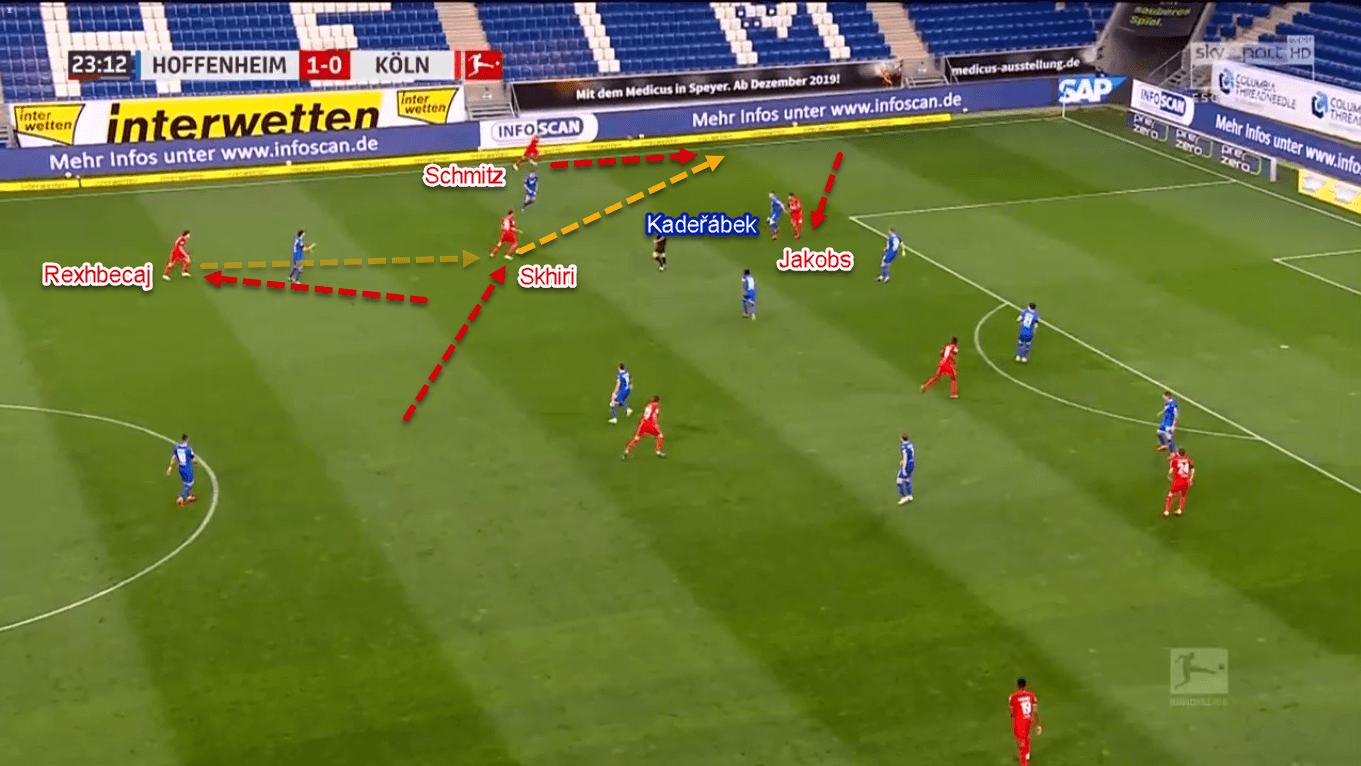
Gisdol reacted well with only ten men
Just about six minutes from the half-hour mark, Bornauw attempted a harsh tackle on Baumgartner. Initially, the defender was given the yellow card before referee Felix Brych consulted with VAR; thus expelling the defender after the monitor check. In the beginning, Gisdol reacted by moving his team to a 4–4–1 and dropping Skhiri as a makeshift centre-back.
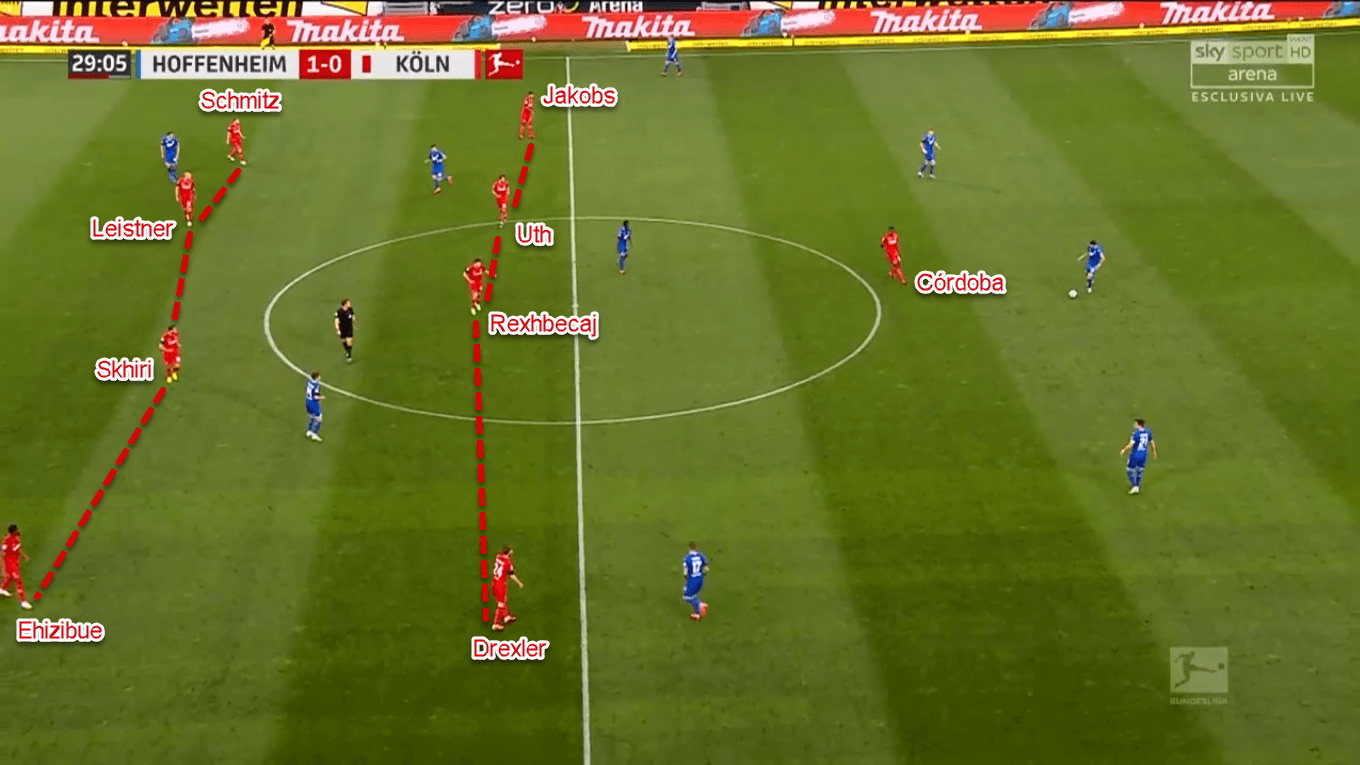
However, this only lasted for five minutes or so. The manager subbed Ehizibue off and send centre-back Meré in. It’s not the only adjustment he made. He moved Schmitz to the right-back position, pulled Jakobs to the left-back, and changed the shape to a 4–3–2. The midfield trio consisted of Dominick Drexler, Skhiri, and Rexhbecaj. Attacking midfielder Mark Uth joined Córdoba in the offensive line.
Despite the changes, Gisdol’s defensive focus stayed the same. Köln kept the central area relatively sterile from any Hoffenheim player. Sometimes they could also be found in a 4–1–2–1–1 or 4–3–1–1 shape, with Uth slightly dropping from the forward line.
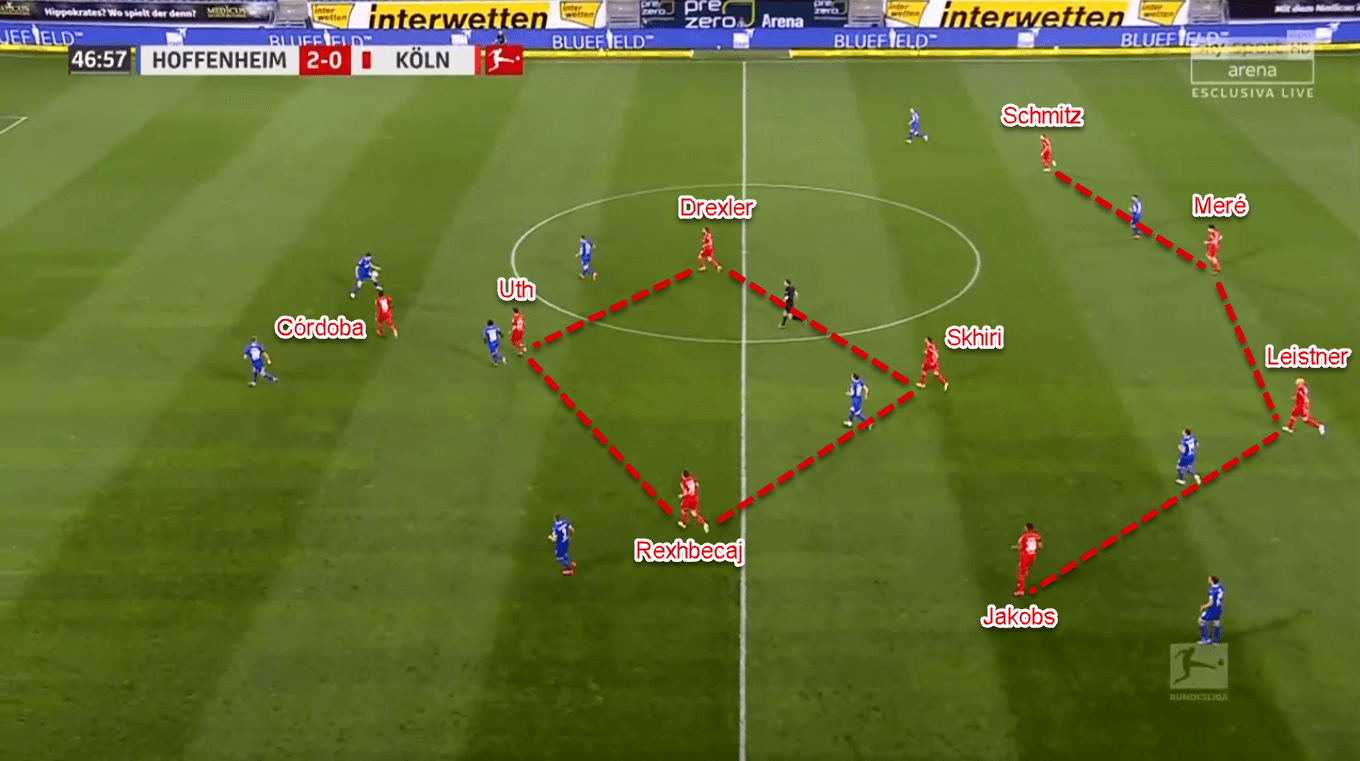
Offensively, Köln changed to a more direct approach. Their main option was by sending long balls to Córdoba upfront. The Colombian striker then would lay the ball off after winning the aerial duel, mainly to the flank. Looking at the statistics, the approach seemed to work well. The stats show that Córdoba won three (75%) of his duels in the air. One of them even resulted in Kainz’ second-half goal.
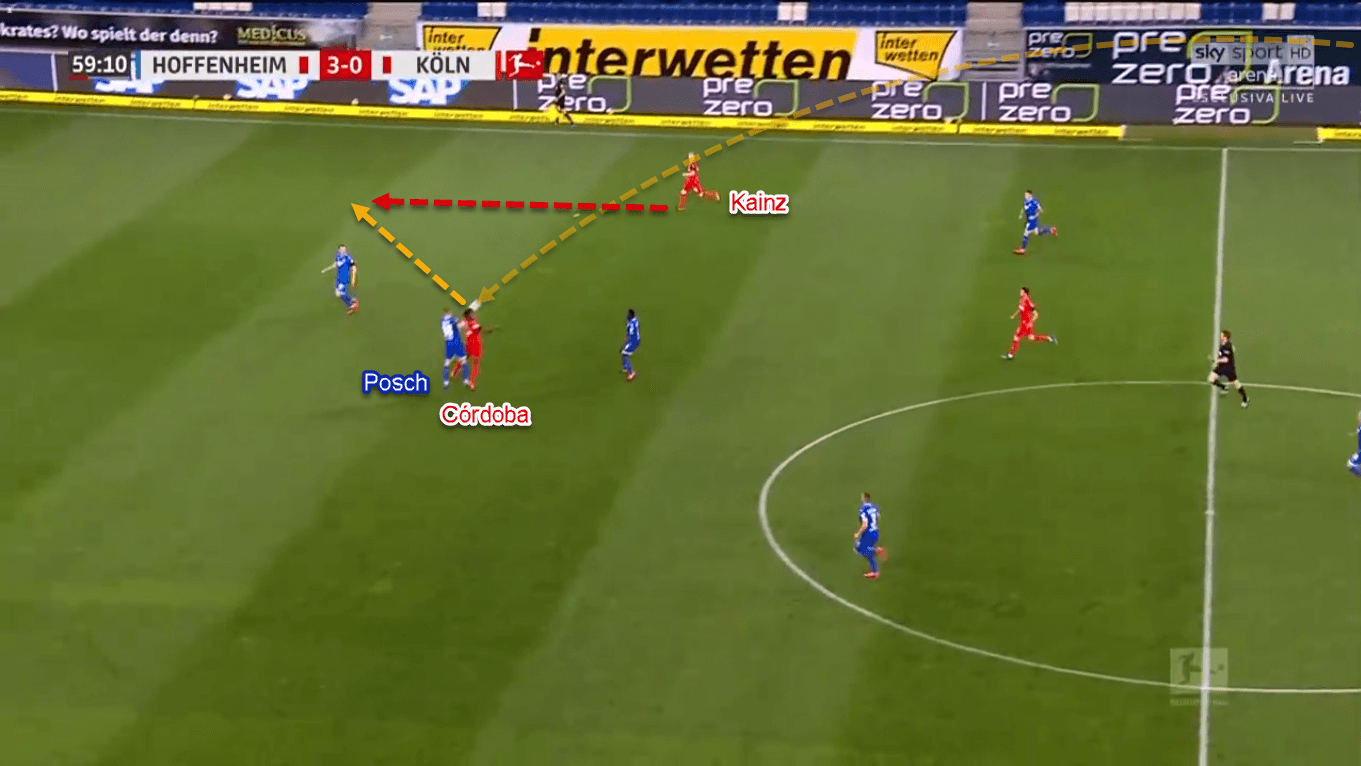
Hoffenheim’s high press
The home side started both halves by pressing Köln high, even up to their penalty box. To do this, Hoffenheim deployed the press in a 4–1–2–3 shape. Schreuder main instruction for the pressing players was to close down the central opponents in a rather man-oriented fashion.
In the process, Dabbur was tasked to press the goalkeeper while his attacking partners in the flanks came inside to close down Köln’s centre-backs. Behind them, two central midfielders would close down Köln’s midfield-pairing. Then, the remaining Hoffenheim midfielder would stay in front of the backline to help his teammates should the ball played long.
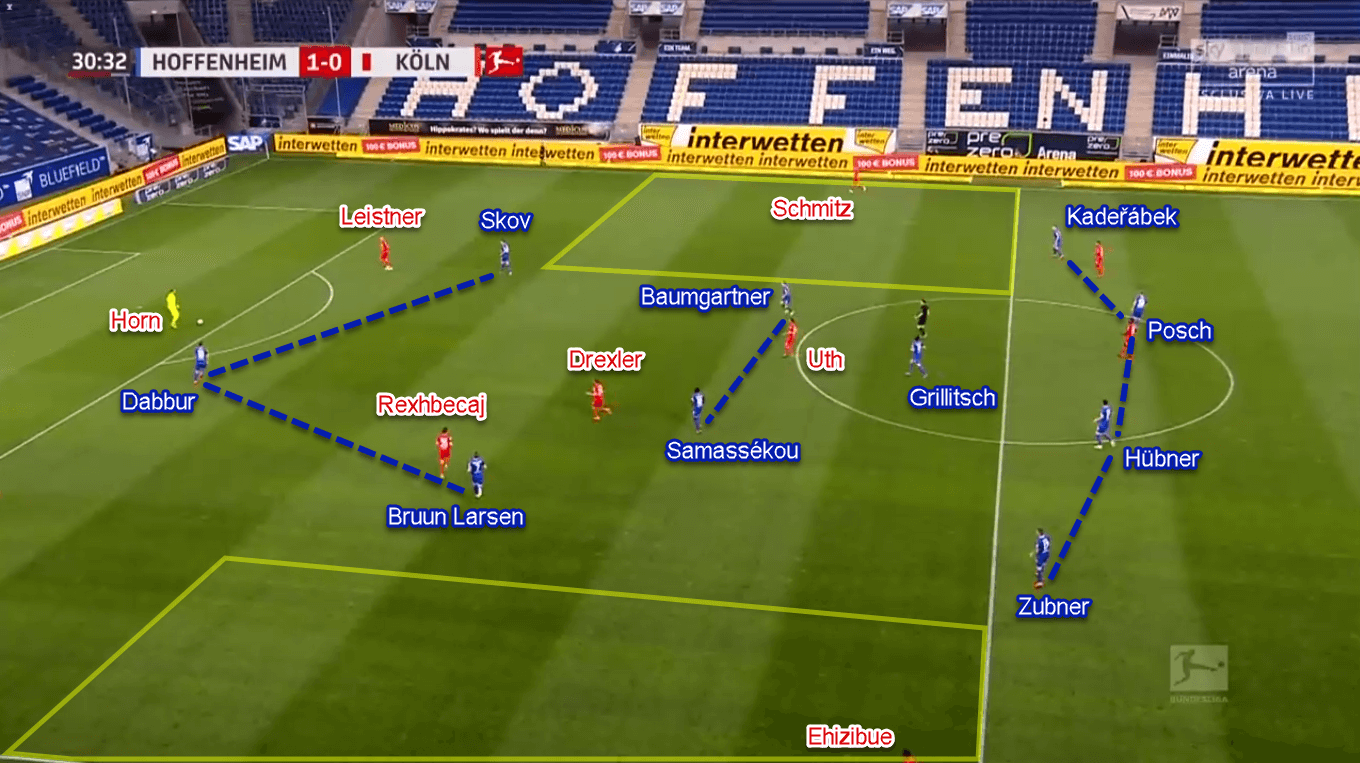
Hoffenheim’s central-focused press neglected the wide area. It means that they would let Köln’s full-backs free at the beginning. However, either the nearby winger or midfielder could come to press the full-back whenever Köln chose to play the ball wide. The high-press was the main reason behind Die Kraichgauer’s second goal.
Second-half adjustments from both managers
Just two minutes after Zuber’s goal, Hoffenheim were also forced to play with just ten men. The reason was Hübner’s second booking after recklessly bringing Drexler down. This resulted in a chain of tactical adjustments from both managers.
First, Gisdol’s offensive adjustment. He abandoned the left-flank scheme and focused more to build from the opposite side. The manager subbed Kainz in for Drexler before the hour mark. By doing so, he allowed Kainz to play in the flanks with Schmitz. The half-space and the central area then would be filled with Uth, Rexhbecaj, and/or Skhiri.
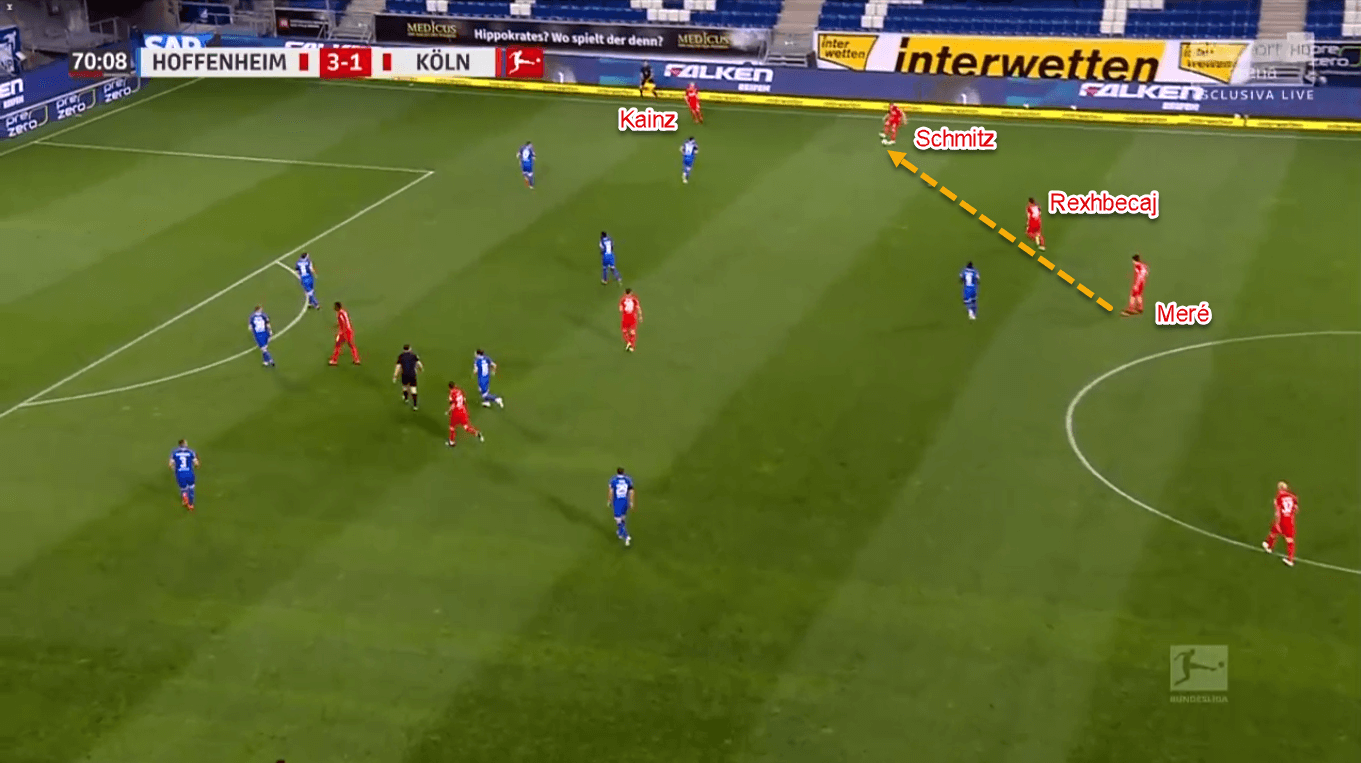
Gisdol didn’t use the ‘dropping midfielder’ play in the second half. Instead, he instructed the ball-side centre-backs to distribute the ball. By doing so, Köln were able to overload the right-wing with up to four players and access them quicker. The objective behind this was to free a player to send crosses for the attackers inside the box.
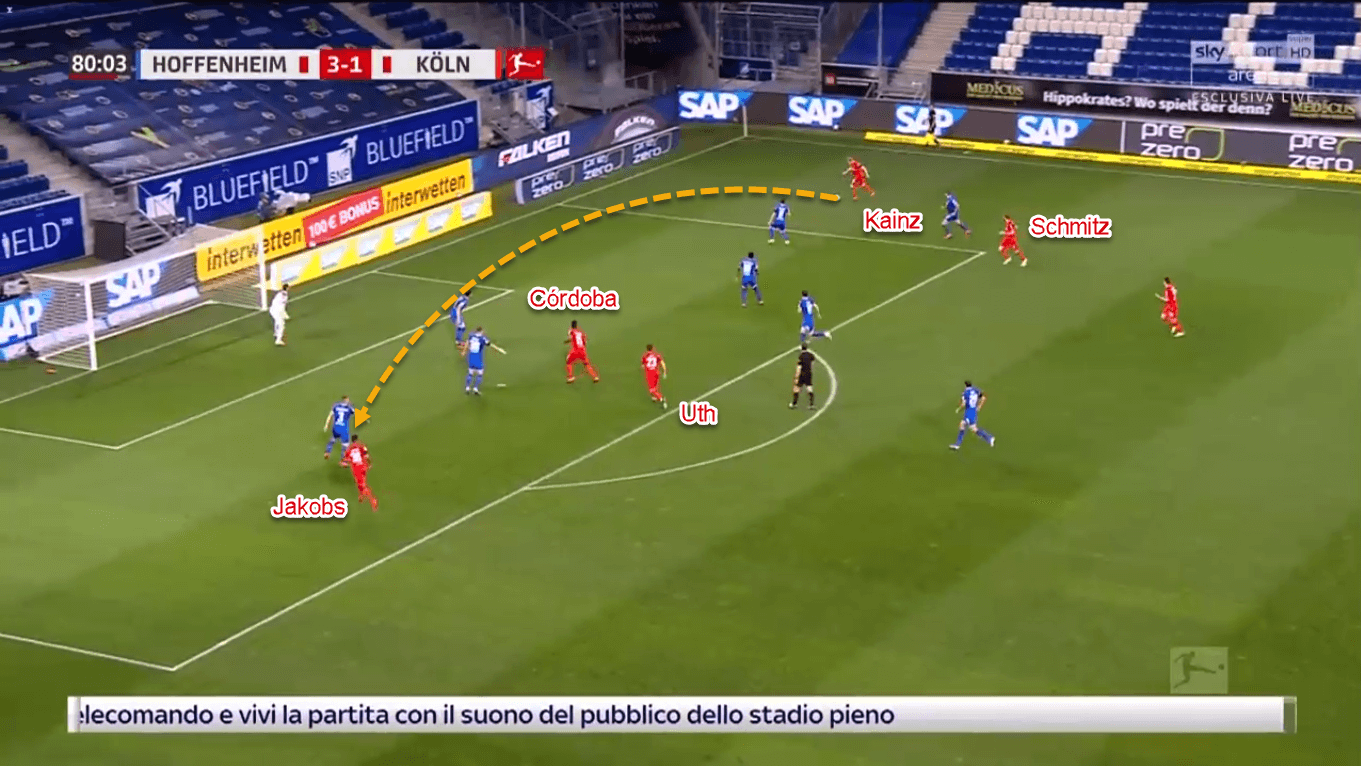
Schreuder reacted to Hübner’s red card by moving his team to a 4–4–1. Sometimes, the shape could be found somewhat lopsided. It’s because Samassékou was tasked to play a bit deeper and prevent the half-space to be accessed. His positioning also made the left-winger retreat a bit and contain Köln’s wing play.
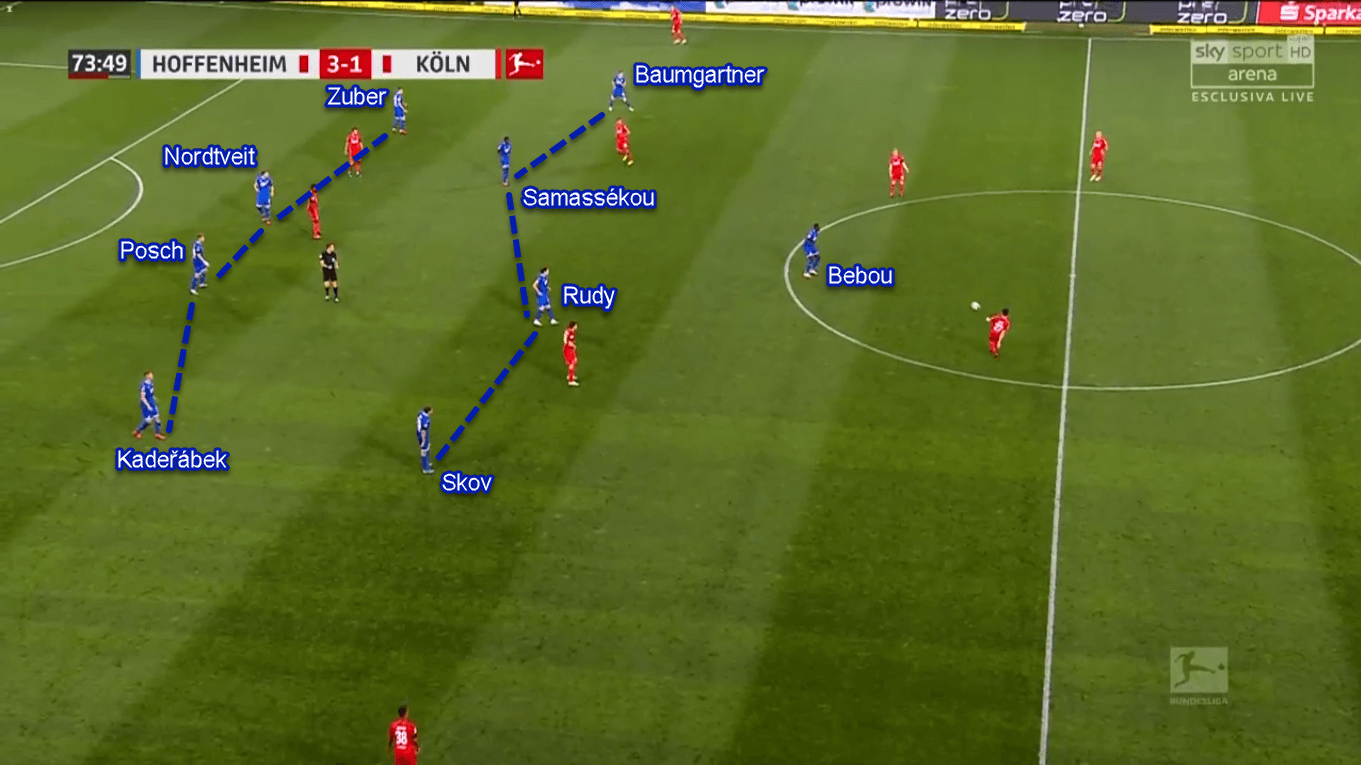
However, the tactics didn’t work as planned. The stats show that Kainz only managed to make three (37.5%) crosses from eight attempts. Schmitz’s statistics were slightly better. He only made two (50%) successful crosses after being moved to the right-back position.
Conclusion
The home side punished Köln’s lack of concentration in their first goal. The similar issue can also be addressed in Hoffenheim’s second-half goals as they happened in very quick succession. The visitors did manage to cause some problems, credit to Gisdol’s brilliant tactical adjustments. They even managed to get a penalty just 15 minutes from the final whistle. However, none of them was enough as the players their chances from time to time.
Some may say Hoffenheim were lucky with the result. If we look at the expected goals (xG) tally, those people may be right. Hoffenheim only had 0.9 xG while Köln managed to have 1.56. Yet, the scoreline is the most important statistics of them all. Die Kraichgauer now can smile widely as they move closer into the European zone with the victory.
Can they keep the momentum and secure a Champions League ticket for next season? Let’s wait and see.





Comments